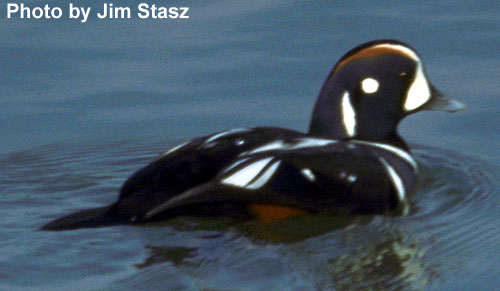
(Currently studied by CWE researchers Jeanine Bond and Sunny LeBourdais
Harlequin Ducks (Histrionicus histrionicus) are small diving ducks that breed at inland streams and winter on the coast. They have long-term pair bonds, uniparental care, and are strongly philopatric to breeding, wintering and moulting sites. Pairing occurs during winter. This species has generated considerable conservation concern. They are endangered on the east coast of North America, and in the west, recruitment is low and does not appear to compensate for adult mortality. In order to increase our understanding of the behaviour and population dynamics of Harlequin Ducks, a banding program was initiated on the west coast of British Columbia in 1994. Having individually marked birds is necessary to determine population demographics and to follow movements and behaviour of individuals. At the Centre for Wildlife Ecology we are studying population demographics, age and sex-related dispersal and movement patterns, foraging, spacing, and pairing behaviour, and the importance of herring (Clupea pallasi) spawn to wintering birds. These studies will contribute to our understanding of the distribution, population dynamics, foraging requirements, and time budgets of Harlequin Ducks, all of which are needed for informed management decisions.List of publications on Harlequin Ducks by CWE researchers.
